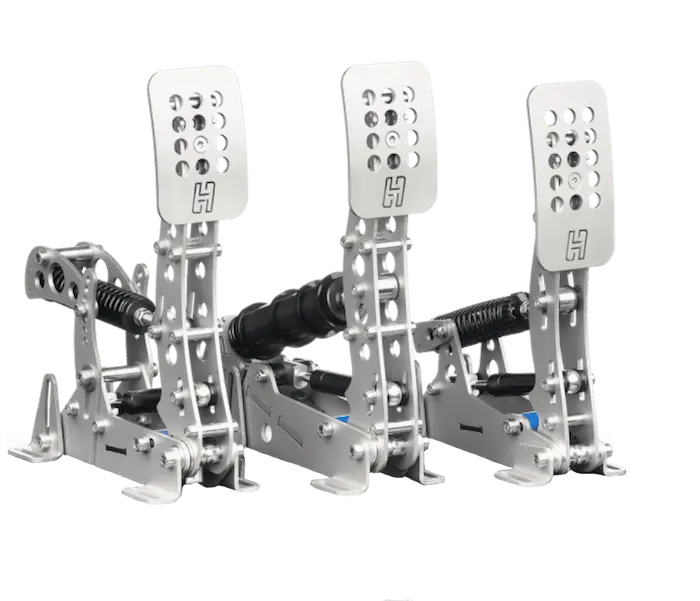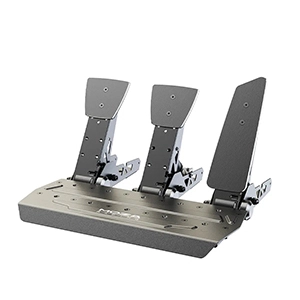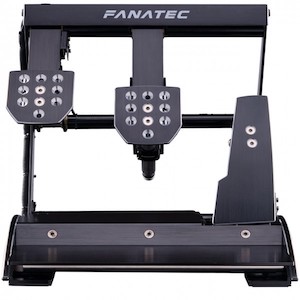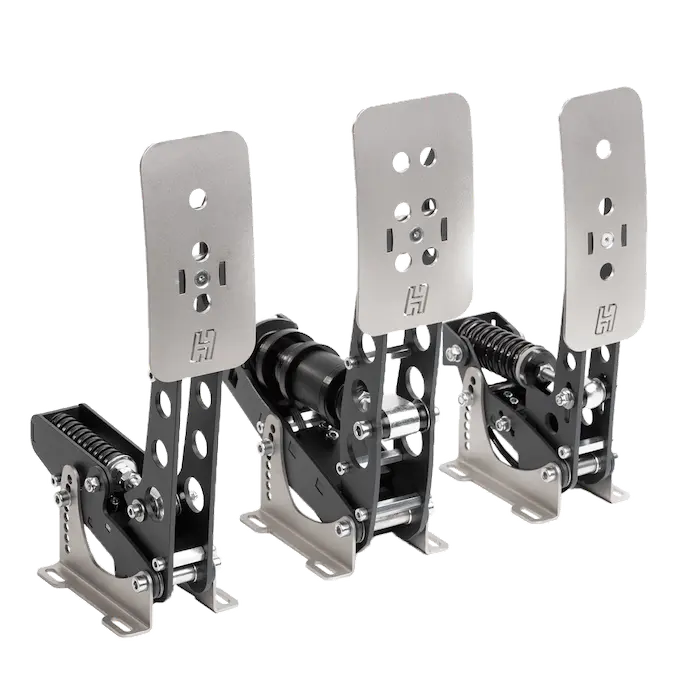Load cell pedals are the most common mid-range options you’ll find in sim racing, but they’re becoming increasingly popular in cheaper sets too. But if you’re a beginner, you might be wondering what load cell sim racing pedals are, and if they’re worth buying.
Load cells measure how much pressure you apply to your sim racing pedals, rather than the distance the pedal travels when you press it. They cost more than potentiometers, but they’re far more accurate and realistic. They’re worth it for beginners and more experienced racers.
This can make for some very realistic sim racing experiences, and it can be a great way to improve your racing abilities as well. We compare load cells to potentiometers and even hydraulic pedals below, while also discussing a few of the best load cell pedal sets on the market.
- • Incredible build quality
- • Hydraulic dampers
- • High level of immersion
- • Excellent racing aesthetic
- • Brilliant load cell brake
- • Vibration on brake and gas
- • Ideal for beginners
- • Adjustable load cell brake
- • Sturdy set of pedals
Load Cell vs Potentiometer Sim Racing Pedals
A good set of pedals should be one of your first considerations when setting up your sim racing rig. There are plenty of options on the market, and if you are a beginner or an intermediate racer, you will probably be drawn to some of the more traditional sim racing pedals sets, and these are ones that use a mechanism called a potentiometer.
Potentiometers Are Fine For Beginners
A potentiometer measures the distance that the pedal travels, often simply called the travel, and then converts this into a corresponding voltage. It is a simple electronic component that does a very good job of converting a physical action into a signal that can be picked up by another component.
In this case, it measures how far you press the pedal, and this tells the game how much braking force to apply. This is a good method of replicating the movements that you make with your feet and emulating that in the game. Although a fairly basic piece of technology, it’s still very useful in sim racing as it used across many cheap pedal sets. They lack accuracy, but they are cheap and easy to implement.
Load Cells Are More Accurate
A load cell is a component that measures pressure, rather than distance or travel. It is not simply the amount of movement that will determine the response of each one in the game, and instead it’s about how hard you press them. Load cells also often use a spring to provide resistance, which is the common method used in potentiometer pedal sets as well.
By using the pressure – in other words the strength of the force you use to press the pedal – the load cell can convert this into a voltage in a similar way to the potentiometer. This is then reflected in the game, and it is often much more accurate as they tend to be able to pick up much finer resolutions, and so this often leads to a more realistic experience.
Note: While potentiometers are still used in some pedal sets, many brands are moving towards using Hall effect sensors instead. These still measure how far you push the pedal, but they use non-contact magnets, making for a more durable product. The cheapest of these kinds of pedals are the Fanatec CSLs.
Load Cell vs Potentiometer Pedals Price
Potentiometer pedal sets will always be a cheaper option than their load cell counterparts. They can cost as little as $100 or less, but they can also run into the several hundreds of dollars. They are also often bundled with wheels and other peripherals, and so they are a great option for those on a tight budget.
Load cells on the other hand are a bit more expensive. They often start at a couple of hundred dollars, but they can cost $500+ for a really high-end set. They also don’t tend to come bundled with wheels and other equipment unlike the potentiometer pedals, and you will often see some brake, clutch and throttle pedals sold individually, which can be very useful for customization purposes.
The Benefits Of Load Cell Pedals
The prices of potentiometer pedals and load cell pedals can sometimes be quite similar, but of course they can also vary a lot at the extremes. The important difference between the two is the level of immersion that each one provides. Potentiometer pedals do provide enough feedback and realism to make them good enough for beginner sim racers, but they do lack accuracy and durability.
The main area in which they are not highly accurate is the brake pedal. Braking in real life involves a lot of fine control, and most potentiometers will just not provide enough resolution to give you this. However, the gas pedal and the clutch don’t really need to have as much control, and so a potentiometer (or Hall effect sensor) can usually provide enough immersion for these.
An Upgrade In All Aspects
That is not to say that a load cell clutch pedal will not make a difference, as in fact it can offer a lot of control through its inherent customizability. It can also make a big difference for the throttle pedal, as more control is obviously better. However, the main pedal that will provide a really noticeable difference is the brake pedal, and so this is often why people choose them.
Buyer’s Tip: An example of pedals that use load cells on the brake, gas and clutch are the Heusinkveld Sprint pedals
Although a potentiometer can replicate the movements of the pedals and to some extent the response, the load cell options just allow for far more detail. They often feel much better and are usually made of higher quality materials too, which adds to the immersion. However, it is this increased resolution that makes load cell pedals far superior to potentiometer options.
The Element Of Customization
Load cell options also tend to offer a lot of customization. This is sometimes achieved via software, but they can also usually be tuned manually on the actual pedals themselves. The pedals also often come as individual parts, which means that if you want to keep your existing clutch and accelerator but upgrade the brake pedal, you are often usually be able to do this, such as with the Fanatec CSLs.
KEY POINTS
• Potentiometer pedals are fine for beginners, but they’re not as accurate or as realistic as load cells
• Load cells are more expensive, but they provide far more immersion
• You can still get some load cell pedals fairly cheap
3 Of The Best Load Cell Sim Racing Pedals
1. Fanatec ClubSport V3 Inverted
The Fanatec ClubSport V3 pedals in their inverted form (there’s also a cheaper non-inverted set) are some of the best looking and best performing load cell pedals on the market (and definitely the best Fanatec pedals). They feature a great load cell brake that offers excellent realism, but they also provide vibration function on the brake and throttle for extra immersion. They’re even console compatible too!
Fanatec ClubSport V3 Inverted
2. Heusinkveld Sprint Pedals
Heusinkveld are one of the best brands in the business, and their Sprint pedals are some of the slickest options you’ll find. They feature load cells on all three pedals for a fully immersive and realistic racing experience, and they’re made from precision CNC laser cut steel for the ultimate durability.
Heusinkveld Sprint Pedals
3. MOZA SR-P Pedals
MOZA are a fairly new brand on the sim racing scene, but they produce many budget friendly products that offer a far from cheap experience. Their load cell SR-P pedals are the cheapest load cell options on the market, and they’re designed to be beginner friendly too. If you want to join an exciting ecosystem of products as a beginner, the SR-P pedals are well worth checking out.
MOZA SR-P Pedals
Check PriceWhich Sim Racing Pedals Should You Buy?
Potentiometer Is Best For Beginners
As a beginner, especially if you’re on a budget, you almost always want to go for a potentiometer (or Hall effect based) based set of pedals. This is mainly due to their price point, as you will probably not want to spend hundreds of dollars on a set of pedals as soon as you get started, unless you have a big budget.
With that said, you should try and get one of the higher end sets if you can, as these will provide the best experience at the lowest price. Potentiometer pedals still provide enough immersion for those new to sim racing to get the hang of things, and you can always upgrade later. They are also fine for intermediate racers, but more experienced players will definitely want to go for load cells.
Load Cells Are Almost Essential For Advanced Racers
The amount of control and immersion that load cell pedals provide is simply so much better than what a potentiometer can offer, so they are well worth the higher price tag for those that are serious about sim racing. A lot of load cell pedals are modeled after real cars, so they are designed to be as realistic as possible while still not being obscenely expensive.
Even if you are a beginner or an intermediate sim racer, a set of load cell pedals can be a smart investment for the sheer quality of their construction. Not only that, but they can also help you to become a better sim racer too, through their increased resolution and ability to control your movements in a much more realistic way.
What About Hydraulic Sim Racing Pedals?
Before we conclude, it’s also worth mentioning another popular type of sim racing pedals you might come across. Hydraulic pedals are some of the most desired options in the world of competitive sim racing, but they are also some of the most expensive. This is because they provide the most lifelike pedal experience possible, and there is some really advanced technology contained within them.
The Most Realistic & The Most Expensive
Real cars use hydraulic braking systems, and so hydraulic pedal sets provide the most immersive experience just due to their physical construction. Obviously, they have to be well made, and most choices on the market are, but you will have to pay a premium for this quality – these pedals typically cost several thousand dollars.
This high price point will deter most sim racers, and if you are a beginner or intermediate sim racer then you definitely don’t need to upgrade to hydraulic pedals in order to have an immersive experience. However, if you are a serious sim racer with lots of experience and a big budget, and potentially racing competitively, hydraulic sim racing pedals are the next step up from load cells.
Final Thoughts
Load cell pedals are some of the best options on the pedal market for sim racers, and they come in at various different price points. This makes them a suitable choice for all levels of experience. However, they are definitely more suited to intermediate to advanced racers. They provide a lot of realism and immersion, and they usually don’t cost that much more than potentiometer-based pedals.
I created and have been writing on this site since 2019, collaborating with drivers, coaches, engineers and manufacturers to provide you with the most reliable information about motorsport. I also make beautiful car posters and track posters.








